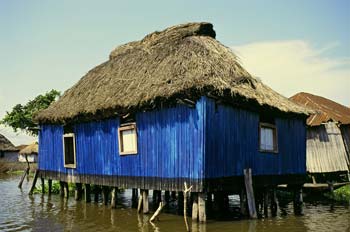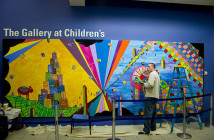Composition is the most basic underpinning of visual communication, if not all visual art-making. It is both a tool and a skill, learned and innate, which when employed well, often goes unnoticed by the viewer. artSpace@16's current show, Four Compositions by Four Maldonians examines different uses of composition, each by a different artist, each of whom is much different than the others. With each artist, composition comes from within or without and includes different takes on the concept composition itself.
Paul J. Sieswerda documented a trip to Benin with photographs one might easily find in a National Geographic Magazine. His work is "straight photography" with a very large depth of field, allowing the viewer to take in every detail from within the frame, but he relies on an adept use of composition to guide your eye through each photo. Color, line and perspective delineate sections of each frame providing a photograph that doesn't seem to over-prejudice itself with any specific features.
Sieswerda, who spends most of his days as a General Contractor, made the trip to Benin in the fall of 2004 with his father, Paul L. Sieswerda, the curator of the New York Aquarium in an exchange program sponsored by the International Partnership among Museums (IPAM). There is not doubt that Sieswerda junior is a natural photographer, having the innate ability to create beautiful, contemplative images in the flash of a couple milliseconds. The speed of photography, however, also enabled him to take many pictures, which his subjects wished that he had not. Sieswerda admitted that many of the people he had take pictures of did not want their pictures taken for both religious reasons and that they were sick of people taking their picture; one of the photographs in the show has a young boy, though cut off by some of the frame, shaking his fist at Sieswerda as he passed by the boy on a boat and took a picture.
Somewhat troubling are the terms "primitive" and "exotic" as employed in the press release, which became deprecatory words in social science decades ago. Whether Sieswerda took the photographs because he thought the local Beninese people were interesting subjects or not, many viewers will undoubtedly do so, despite the photographs just being people engaged in day-to-day activities. This exoticism of the photographs' subjects relegates Sieswerda's work to pre-Edward Evan Evans-Pritchard anthropology, however, Sieswerda was indeed an avid participant in the local Beninese belief system, practicing Voodoo in an attempt to stymie the Yankees and Cardinals during Major League Baseball's Division and World Series that fall. (Apparently it worked, and Sieswerda takes credit for it.)
Wesley Kalloch's work from his series, Minor Erections, is self-consciously composition. His photographs of buildings in the midst of construction are composition-responsive as they are both images of strictly defined lines (the steel beams of buildings' skeletal structure) and, indeed, pictures of compositions. Not that they are simply photographs of frames (image-based or architectural) already in place-each photo finds a different way to arrange the grid of a building's skeleton, while a random power line might slice the frame in half, yet they do leave less to the imagination than Sieswerda's.
Stephen deFilippis's compositions consist of welded metal from formerly disassociated parts. The owner of Urban Auto Body in Lynn, deFilippis is surrounded by twisted and smashed collections of metal every day. His pieces are sculptural reliefs that he created by cutting shards of metal from car bodies and reassembling them into abstract and dramatic shapes. His sculptures have an aesthetic of a Willem de Kooning painting, and emulate the process oriented works of other abstract expressionists, yet they are more about the composition of parallel lines into an ending shape which follows the same drama of the composition and materials. The works are enjoyable as objects that conjure their fiery creation or simply as remnants of their history as auto-parts.
Sand T's works from her series, Upper Story, takes composition a step further by enlisting it to tell stories about her life in three-dimensional works. Her illuminated sculptures are cube-like structures, the walls of which she created from found plexi-glass that she sanded and applied resin, text, paper scraps and pictures to. The text, in three different languages (Sand T, an ethnically-Chinese Malaysian speaks five) and images are effectively applied in layers of decreasing transparency to represent more distant memories. It is helpful to have Sand T present to elaborate on the somewhat abstrusely rendered narratives she has created with each sculpture. However, each one of her memories involves a structure, whether it be the home she grew up in or this very gallery-which she founded and directs-and each one of the sculptures enables us to better realize Sand T's experiences while we might learn something about our own memories.
The show's "composition," most of whom are artists that are relatively unknown is something we must credit Sand T for. None of the artists seem to have a large portfolio, nor do they frequently show work except for Sand T, herself, who has been running artSpace@16 since 2000. Wesley Kalloch, who is Sand T's husband, does have several shows to his artist resume, but like Sieswerda and deFilippis, has a career occupation in an unrelated field as the Horticultural Technologist at the Arnold Arboretum. Moreover, showing us the works in a way that coheres with their common significance is a feat of creativity and ingenuity that speaks to her status as a star in Malden. The only complaint one may muster about artSpace@16 is that it's in Malden; for now we must reconcile with our Maldonian-envy.
- Paul J. Sieswerda, Blue Hut, Ganvie, archivaldigital print.
- Wesley Kalloch, Minor Erections 003, C-print.
- Stephen deFilippis, Spinner, assembled metal sculpture.
Links:
artSpace@16
An interview with Sand T by Kathleen Bitetti
"Four Compositions by four Maldonians" is on view through 17 February at artSpace@16.
All images are courtesy of the artist and artSpace@16.






